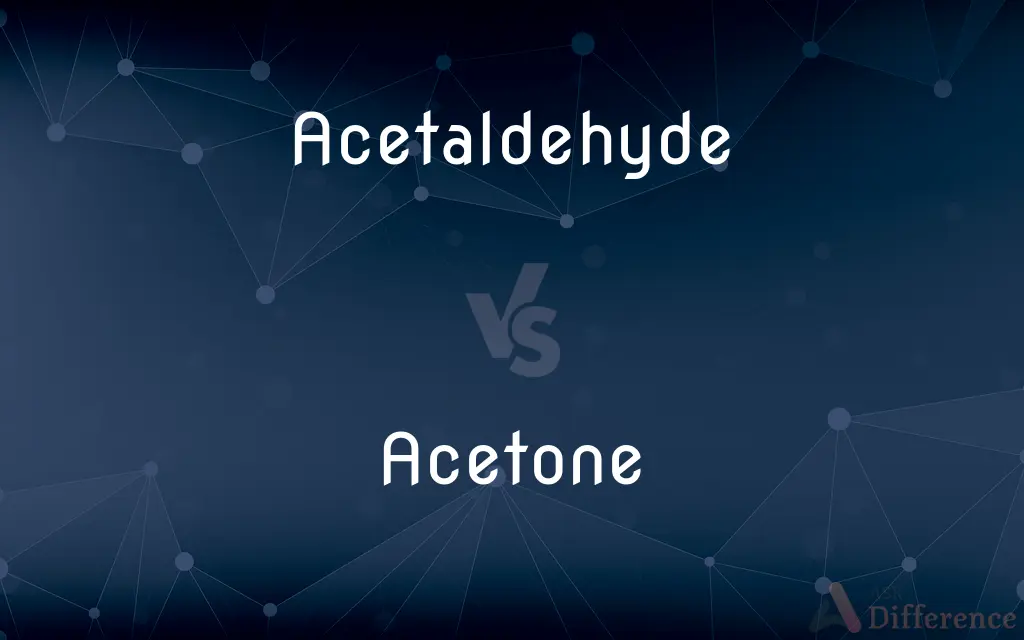Acetaldehyde vs. Acetone — What's the Difference?
By Tayyaba Rehman — Updated on September 23, 2023
Acetaldehyde is a flammable organic compound with a strong pungent smell, while Acetone is a colorless, volatile solvent commonly found in nail polish remover.

Difference Between Acetaldehyde and Acetone
Table of Contents
ADVERTISEMENT
Key Differences
Acetaldehyde and Acetone are both organic compounds with distinct chemical structures and properties. Acetaldehyde, with its chemical formula CH3CHO, is the simplest aldehyde. It is often characterized by its pungent smell and is primarily used as an intermediate in the synthesis of other chemicals. Acetone, with its formula (CH3)2CO, is the simplest ketone and is a common solvent used in various industries, especially in cosmetics like nail polish removers.
From a structural perspective, Acetaldehyde has a carbonyl group (C=O) bonded to a hydrogen atom and a methyl group, which makes it an aldehyde. In contrast, Acetone has the carbonyl group situated between two methyl groups, categorizing it as a ketone. This difference in structure influences their chemical reactivity and the types of reactions they undergo.
When it comes to uses, Acetaldehyde has a pivotal role in the production of acetic acid, synthetic resins, and numerous other chemicals. On the other hand, Acetone is primarily recognized for its role as a solvent, especially in paints, plastics, and in the cosmetics industry. Its high volatility and ability to dissolve many organic compounds make it invaluable in these sectors.
In biological contexts, both Acetaldehyde and Acetone have relevance. Acetaldehyde is formed in the body during the breakdown of ethanol, the type of alcohol found in alcoholic beverages. Prolonged exposure can have detrimental health effects. Acetone, while naturally present in small amounts in the human body, is also a breakdown product of fat metabolism.
Comparison Chart
Chemical Formula
CH3CHO
(CH3)2CO
ADVERTISEMENT
Compound Type
Aldehyde
Ketone
Common Uses
Production of acetic acid, synthetic resins
Solvent for paints, plastics, cosmetics
Odor
Pungent
Sweet, somewhat fruity
Biological Relevance
Formed during ethanol breakdown
Breakdown product of fat metabolism
Compare with Definitions
Acetaldehyde
An organic compound with a strong odor.
Acetaldehyde can be formed during alcohol metabolism.
Acetone
The simplest ketone.
Acetone is a primary ingredient in many nail polish removers.
Acetaldehyde
The simplest aldehyde.
Acetaldehyde is used in producing synthetic resins.
Acetone
Effective in dissolving many organic compounds.
Acetone can easily dissolve certain types of plastic.
Acetaldehyde
Flammable and colorless.
The room was filled with the distinct pungent smell of Acetaldehyde.
Acetone
A colorless and volatile solvent.
Paint thinners often contain Acetone.
Acetaldehyde
Used as an intermediate in chemical synthesis.
The production of acetic acid involves Acetaldehyde.
Acetone
Present in small amounts in the human body.
During fat metabolism, the body can produce Acetone.
Acetaldehyde
Can be derived from ethanol oxidation.
The liver processes ethanol into Acetaldehyde.
Acetone
Used in the manufacture of plastics and fibers.
Acetone is a crucial solvent in the production of acrylic plastic.
Acetaldehyde
Ethanal (common name acetaldehyde) is an organic chemical compound with the formula CH3CHO, sometimes abbreviated by chemists as MeCHO (Me = methyl). It is one of the most important aldehydes, occurring widely in nature and being produced on a large scale in industry.
Acetone
Acetone, or propanone, is an organic compound with the formula (CH3)2CO. It is the simplest and smallest ketone. It is a colourless, highly volatile and flammable liquid with a characteristic pungent odour.
Acetaldehyde
A colorless, flammable liquid, C2H4O, used to manufacture acetic acid, perfumes, and drugs.
Acetone
A colorless, volatile, extremely flammable liquid ketone, C3H6O, widely used as an organic solvent. It is one of the ketone bodies that accumulate in the blood and urine when fat is being metabolized.
Acetaldehyde
(organic compound) An organic compound, (CH3CHO). Sometimes called ethanal or acetic aldehyde. See aldehyde.
Acetone
(organic compound) A colourless, volatile, flammable liquid ketone, (CH3)2CO, used as a solvent.
Acetaldehyde
Acetic aldehyde. See Aldehyde.
Acetone
A volatile liquid consisting of three parts of carbon, six of hydrogen, and one of oxygen; pyroacetic spirit, - obtained by the distillation of certain acetates, or by the destructive distillation of citric acid, starch, sugar, or gum, with quicklime.
Acetaldehyde
A colorless volatile water-soluble liquid aldehyde used chiefly in manufacture of acetic acid and perfumes and drugs
Acetone
The simplest ketone; a highly inflammable liquid widely used as an organic solvent and as material for making plastics
Common Curiosities
What is a primary use of Acetaldehyde in industry?
Acetaldehyde is used mainly in the production of acetic acid and synthetic resins.
What type of organic compound is Acetaldehyde?
Acetaldehyde is the simplest aldehyde.
Is Acetone naturally present in our bodies?
Yes, Acetone is naturally produced in small amounts during fat metabolism.
In what products might I find Acetone?
Acetone is commonly found in nail polish removers and paint thinners.
Is Acetone flammable?
Yes, Acetone is highly flammable.
Why does Acetaldehyde have a strong smell?
Its molecular structure gives it a pungent odor characteristic of aldehydes.
In what biological process is Acetaldehyde formed?
Acetaldehyde is formed during the breakdown of ethanol in the body.
What are the health implications of prolonged Acetaldehyde exposure?
Prolonged exposure to Acetaldehyde can be harmful and is linked to certain cancers.
How does the structure of Acetone differ from that of Acetaldehyde?
Acetone is a ketone with two methyl groups, while Acetaldehyde is an aldehyde with one hydrogen and one methyl group attached to the carbonyl.
Can both Acetaldehyde and Acetone dissolve plastics?
Acetone is notably effective in dissolving many plastics, while Acetaldehyde has different solvency characteristics.
Which compound, Acetaldehyde or Acetone, is commonly used as a solvent?
Acetone is widely used as a solvent in various industries.
Share Your Discovery

Previous Comparison
Journal vs. Ledger
Next Comparison
Rights vs. FreedomAuthor Spotlight
Written by
Tayyaba RehmanTayyaba Rehman is a distinguished writer, currently serving as a primary contributor to askdifference.com. As a researcher in semantics and etymology, Tayyaba's passion for the complexity of languages and their distinctions has found a perfect home on the platform. Tayyaba delves into the intricacies of language, distinguishing between commonly confused words and phrases, thereby providing clarity for readers worldwide.














































